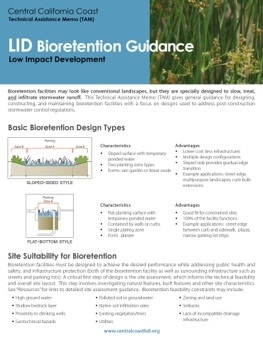LID Design and Construction
Although LID projects may look like conventional projects, especially the vegetated designs, there are key differences that designers and contractors must consider. LID design begins at the site scale; mimicing the hydrolgic processes of a predevelopment landscape by disconnecting from conventional grey infrastructure and dispersing stormwater runoff to pervious areas. LID projects provide water quality treatment for small storms by capturing, filtering, and infiltrating rainwater in specially designed features where it falls.

LID structural stormwater features incorporate unique design elements, materials, and construction methods to provide these valuable services. Incorrect design or construction can reduce or eliminate this intended function. Common mistakes in LID include use of the wrong plants or soil mix; incorrect placement or elevation of overflow inlets; and, improper grading that hinders the stormwater runoff from entering the facility.
Using good design details and specifications is a crucial first step toward a successful project. LIDI has focused on bioretention design as this type of LID facility is one of the most commonly used. LIDI worked with state and national LID experts to improve bioretention details and specifications based on years of implementation and lessons learned. This website provides designers with a full set of AutoCAD standard details for bioretention facilities and the associated infrastructure elements such as curb cuts, overflow inlets, and check dams; as well as guidance on bioretention soil media and plants.

Use of correct materials such as bioretention soil media and plants is also very important to achieve a successful LID project. Material specifications,
guidance for installation and a list of regional vendors are available.
And for those new to constructing LID projects, we have created a guidance document that covers key elements of LID construction such as special construction methods, use of material substitutions, and impacts to project schedule.